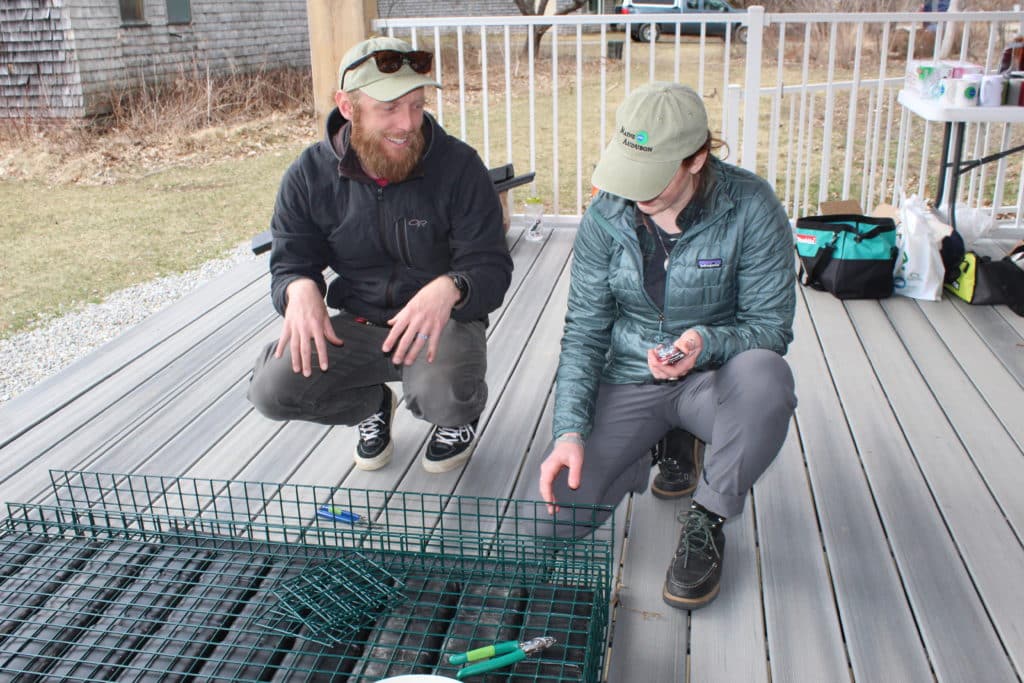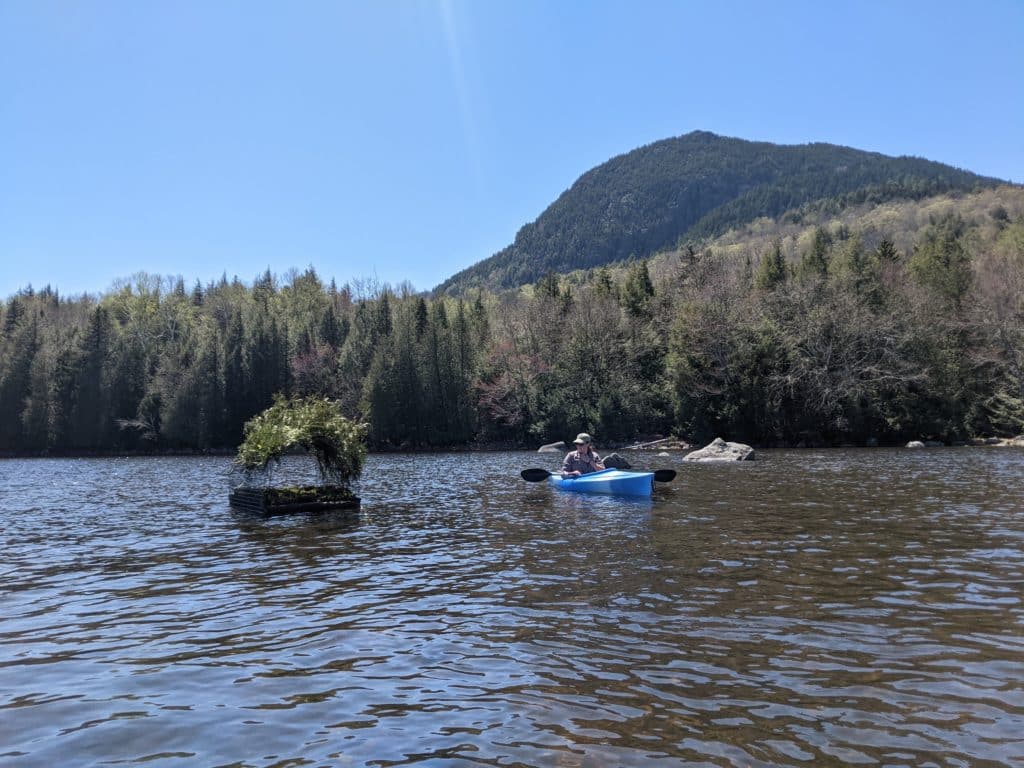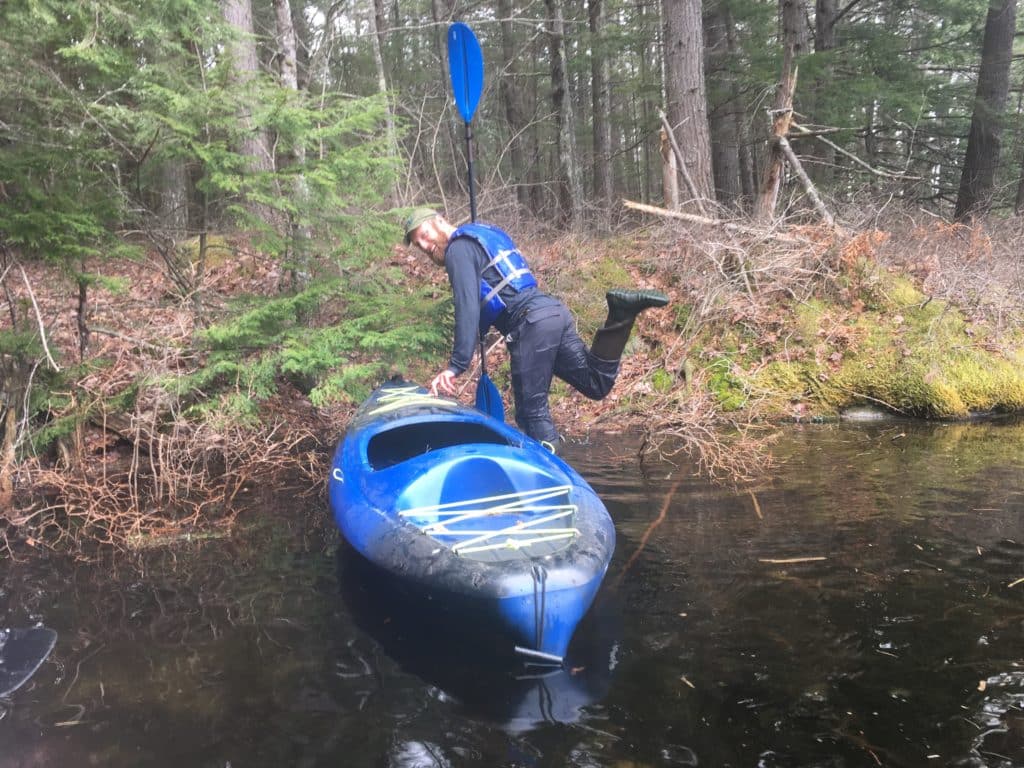
What’s it like to work with loons in the field? For the spring and summer of 2022, two seasonal biologists, Earl Johnson and Jill Marianacci, have been working with Maine Audubon on the Loon Restoration Project, doing everything from building artificial nests for loons that struggle to hatch chicks, scouting lakes to find suitable sites, placing rafts, trying to address threats to loons, and working with teams of volunteers across the state.
The Maine Loon Restoration Project is a five-year project, funded by an oil spill settlement, that aims to give Maine loons better chances for breeding success and decrease loon mortality by engaging volunteers in a number of ways, including placing these artificial rafts. The goal of the raft program is to increase the number of loon chicks hatched through placement of nearly 100 artificial nesting rafts through 2026 in territories with low nesting success. The raft program started with a few rafts in 2021 and really began in earnest in the spring of 2022; Maine Audubon had 16 rafts on Maine lakes this summer. Seven of these were used as nesting locations and six chicks hatched; it typically takes one to three years for loon pairs to take to rafts, so this early success exceeded our expectations.
An additional 11 loon rafts were also placed by our partners in the Loon Restoration Project—Maine Lakes, Lakes Environmental Association, and the Penobscot Nation—with the help and dedication of lake associations and local residents.
As the season winds down, Jill and Earl paused to think about the season and describe the challenges, successes, and lessons learned from loons this summer.
Which aspect of the fieldwork was most interesting to you?
Earl: Aside from spending time outside and getting to observe the sheer productivity of summer firsthand, what I found most interesting about the fieldwork portion of this position was trying to get into the heads of the loons. Many bird fieldwork positions are more cut and dried (do this at this date and time and you will have success), but this position was interesting in that it kept us guessing and trying to think like loons in order to offer them nesting opportunities in places they might actually be interested in!
Jill: When thinking about placing nesting platforms, we try to collect as much evidence around the lake as possible—previous nesting sites including suspected reasons for failure, human disturbance aspects, any water level fluctuation, and presence of predators. For me the most interesting part was connecting all those dots from gathered information, and using that to determine the level of restoration efforts we can provide for loon pairs!
What was the most challenging part of this summer?
Earl: For me, the most difficult part of the season was letting go! Throughout the season it got easier, but at first it was really hard for me to spend lots of time and mental energy picking the “perfect” spot for a loon nesting platform only to have it sit empty all season. That being said, we did have a surprising amount of success with getting rafts used this year!

Jill: For me some of the most challenging parts of this summer sometimes ended up being the most fun! Towing heavy, bulky rafts behind a kayak at the will of lake conditions can definitely prove to be difficult depending on the weather! There were days where we would struggle through wind, rain, and adverse weather to complete our work. The challenge of getting our job done no matter what mother nature presented made for some of the most memorable field days.
What was the most unexpected part of the project?
Jill: The level of enthusiasm and passion for loons from our project participants, as well as other folks we had the pleasure of meeting at events, is what surprised me the most. Moving to Maine from the Finger Lakes of NY, I always knew loons were a charismatic bird, but I never knew how committed Mainers are to helping ensure a thriving loon population. It really was great to work alongside so many passionate people!
Earl: The most unexpected part of the project for me was how hard it was to keep nesting material on some rafts vs. others. I really underestimated the importance of finding a relatively protected spot that would keep waves and wakes from washing plants and nesting material off the raft.
What did/does a typical day (or week) look like for the crew?
Earl: This certainly changed throughout the season, but on average I think we had one to two days a week on the water and three to four days a week on the computer organizing fieldwork, communicating with volunteers, taking care of logistical hurdles, staying organized, and planning for next season.
Jill: A workday varies; either we are out on a lake, working from home, or there is an office day at Gilsland Farm sprinkled in the mix. Basically we’re either deploying rafts, visiting our awesome volunteers for monitoring check ins, performing lake assessments for potential rafts for next year, or doing desk work (which is important too!).
What’s your favorite thing about loons?
Jill: What I like most about loons is their ability to keep us on our toes as loon biologists. They are so variable, and as soon as you think you have them figured out they teach us something new. Each loon pair we focused on brought new challenges and made us stretch our thinking in terms of restoration efforts. Our amazing volunteers as well as our Restoration Team were always learning!
Earl: My favorite thing about loons (besides their fascinating vocalizations) is their ability to vanish. Oftentimes we’d be on the water, we’d see a loon swimming and diving in one location, and then it would just disappear without a trace despite our efforts to relocate it. Sometimes they’re very obvious and sometimes they can be incredibly stealthy—so many interesting behaviors to observe!
What aspect of loon life history was most surprising to you?
Earl: I went into the season knowing that loons were intensely territorial, but I wasn’t prepared for the number or intensity of territorial interactions each loon pair deals with over the course of the season. So many challenges to overcome simply to have the chance to nest and raise young. Amazing there are baby loons at all with all the hurdles they and their parents must overcome!
Jill: As Earl mentioned, the level of territoriality loons demonstrate is mind blowing! Intruder loons are a serious threat to pairs with chicks that have already claimed real estate. Something I never knew about loons is that they perform chick stashing in instances like this. Pretty interesting to think how protective and hands on parents Common Loons can be. A lot of time and energy goes into ensuring chicks fledge!
What was one of your most memorable field days?

Earl: There have been so many memorable field days on this project! One that comes to mind is a visit to the Tacoma Lakes in Litchfield. The day started out with a great investigative paddle around Sand Pond, looking for chicks and natural nest sites. Next we shifted focus to Woodbury Pond, where we were able to see a loon incubating on one of our rafts, always a happy event! From there we decided to check on the chicks and natural nest site at Little Purgatory Pond and we had the option to portage or float through a spiderweb-choked culvert with just enough clearance for our boats. We chose the culvert and hilarity ensued! There were loon chicks on the other side too; an excellent day all around!
Jill: We typically have an idea in our head how each field day will go, and sometimes those plans just don’t work out! On one memorable day, we arrived on site to find out the boat that was going to take us to the site was out of commission, and with no roads to get us to our destination, our team had to hike most of our supplies to the site. With some careful planning to make sure we had all the right tools in our bags, as well as other raft supplies and even potted plants, we came up with a new plan to get the job done. Hiking in alongside the lake provided great views of the water and surrounding mountains. When we finally got to the site, we were able to successfully deploy the raft, and overall had a great day with our volunteers!
What will the biggest challenges be in the next phase of the project?
Jill: With raft numbers doubling next year, the spring time is going to be challenging, and very busy for the team. With the completion of our largest launch year and lots of learning along the way, I am looking forward to fine-tuning our project while working on lakes all across the state in a greater volume.
Earl: I think one of the biggest challenges moving forward is going to be staying organized and communicating well with volunteers and partners while working with ever increasing numbers of lakes. More moving parts without corresponding increases in staff means we’ll be stretched more thinly and will need to maximize efficiency.
What’s your favorite thing about this job?
Earl: My favorite thing about this job was absolutely getting to see so many distinct places and working with so many amazing volunteers! So many great connections this summer!
Jill: Being new to Maine, one of my favorite parts of this project was being able to explore all around the state. Maine has a lot to offer, and our team was very lucky to work in some very special places this summer!
What’s next in the life of a seasonal biologist?
Jill: Trying to figure out the winter season until the next field season rolls around. The uncertainty can be stressful, but also exciting to figure out what’s next!
Earl: Looking for more wildlife or ecological work!

Learn more about the Loon Restoration Project here.
This project is funded by the U.S. Fish and Wildlife Service on behalf of the Bouchard Barge 120 Buzzards Bay Oil Spill Trustees.
